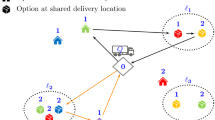Abstract
Routing real-time traffic with maximum packet delay in contemporary telecommunication networks requires not only choosing a path but also reserving transmission capacity along its arcs, as the delay is a nonlinear function of both components. The problem is known to be solvable in polynomial time under quite restrictive assumptions, i.e., equal rate allocations (all arcs are reserved the same capacity) and identical reservation costs, whereas the general problem is \(\mathcal {NP}\)-hard. We first extend the approaches to the equal rate allocation (ERA) version to a pseudo-polynomial Dynamic Programming one for integer arc costs and a FPTAS for the case of general arc costs. We then show that the general problem can be formulated as a mixed-integer Second-Order Cone (SOCP) program and therefore solved with off-the-shelf technology. We compare two formulations: one based on standard big-M constraints and one where Perspective Reformulation techniques are used to tighten the continuous relaxation. Extensive computational experiments on both real-world networks and randomly generated realistic ones show that the ERA approach is fast and provides an effective heuristic for the general problem whenever it manages to find a solution at all, but it fails for a significant fraction of the instances that the SOCP models can solve. We therefore propose a three-pronged approach that combines the fast running time of the ERA algorithm and the effectiveness of the SOCP models, and show that it is capable of solving realistic-sized instances with high accuracy at different levels of network load in a time compatible with real-time usage in an operating environment.
Similar content being viewed by others
References
Saad, M., Leon-Garcia, A., Yu, W.: Optimal network rate allocation under end-to-end quality-of-service requirements. IEEE Trans. Netw. Serv. Manag. 4(3), 40–49 (2007)
Ma, Q., Steenkiste, P.: Quality-of-service routing for traffic with performance guarantees. In: Proceedings of the IFIP International Workshop on Quality of Service, pp. 115–126 (1997)
Orda, A.: Routing with end-to-end QoS guarantees in broadband networks. IEEE/ACM Trans. Netw. 7(3), 365–374 (1999)
Lori, A., Stea, G., Vaglini, G.: Towards resource-optimal routing plans for real-time traffic. In: Margaria, T., Steffen, B. (eds.), Leveraging Applications of Formal Methods, Verification, and Validation. Lecture Notes in Computer Science, vol. 615, pp. 214–227 (2010)
Di Puglia Pugliese, L., Guerriero, F.: A survey of resource constrained shortest path problems: Exact solution approaches. Networks 62(3), 183–200 (2013)
Irnich, S.: Resource extension functions: properties, inversion and generalization to segments. OR Spectrum 30, 113–148 (2008)
Irnich, S., Desaulniers, G.: Shortest path problems with resource constraints. In: Desaulniers, G., Desrosiers, J., Solomon, M. (eds.) Column Generation, pp. 33–65. Springer, Berlin (2005)
Lenzini, L., Mingozzi, E., Stea, G.: A methodology for computing end-to-end delay bounds in FIFO-multiplexing tandems. Perform. Eval. 65, 922–943 (2008)
Lenzini, L., Martorini, L., Mingozzi, E., Stea, G.: Tight end-to-end per-flow delay bounds in FIFO multiplexing sink-tree networks. Perform. Eval. 63, 956–987 (2006)
Lenzini, L., Mingozzi, E., Stea, G.: Eligibility-based round robin for fair and efficient packet scheduling in interconnection networks. IEEE Trans. Parallel Distrib. Syst. 15(3), 254–266 (2004)
Zhang, L.: Virtual clock: a new traffic control algorithm for packet switching networks. ACM SIGCOMM Comput. Commun. Rev. 20(4), 19–29 (1990)
Gallo, G., Pallottino, S.: Shortest path methods: a unifying approach. Math. Progr. Stud. 26, 38–64 (1986)
Frangioni, A., Gentile, C.: Perspective cuts for a class of convex 0–1 mixed integer programs. Math. Program. 106(2), 225–236 (2006)
Frangioni, A., Gentile, C.: A computational comparison of reformulations of the perspective relaxation: SOCP vs. cutting planes. Oper. Res. Lett. 37(3), 206–210 (2009)
Frangioni, A., Gentile, C., Lacalandra, F.: Tighter approximated MILP formulations for unit commitment problems. IEEE Trans. Power Syst. 24(1), 105–113 (2009)
Frangioni, A., Gentile, C., Grande, E., Pacifici, A.: Projected perspective reformulations with applications in design problems. Oper. Res. 59(5), 1225–1232 (2010)
Günlük, O., Linderoth, J.: Perspective reformulation and applications. In: Lee, J., Leyffer, S. (eds.) Mixed Integer Nonlinear Programming. The IMA Volumes in Mathematics and its Applications, vol. 154, pp. 61–89 (2012)
Hijazi, H., Bonami, P., Cornuejols, G., Ouorou, A.: Mixed integer nonlinear programs featuring “On/Off” constraints: convex analysis and applications. Electron. Notes in Discret. Math. 36(1), 1153–1160 (2010)
Tawarmalani, M., Sahinidis, N.: Convex extensions and envelopes of lower semi-continuous functions. Math. Program. 93, 515–532 (2002)
Saino, L., Cocora, C., Pavlou, G.: A toolchain for simplifying network simulation setup. In Proceedings of the 6th International ICST Conference on Simulation Tools and Techniques, SIMUTOOLS ’13 (ICST, ICST, Brussels, Belgium (2013))
Garr: http://www.garr.it
The internet topology zoo: http://www.topology-zoo.org/
Sndlib: http://www.sndlib.zib.de
Waxman, B.: Routing of multipoint connections. IEEE J. Sel. Areas Commun. 6(9), 1617–1622 (1988)
Multicommodity problems. http://www.di.unipi.it/optimize/Data/MMCF.html
Paolucci, F., Cugini, F., Giorgetti, A., Sambo, N., Castoldi, P.: A survey on the path computation element (PCE) architecture. IEEE Commun. Surv. Tutor. 15(4), 1819–1841 (2013)
Acknowledgments
We are very grateful to Giovanni Stea for numerous suggestions and helpful discussions, and to Lorenzo Saino for his precious assistance in using FNSS. This research has been partly funded by the Italian Ministry of Education, University and Research (MIUR) under Grant PRIN 2009XN4ZRR.
Author information
Authors and Affiliations
Corresponding author
Rights and permissions
About this article
Cite this article
Frangioni, A., Galli, L. & Scutellà, M.G. Delay-Constrained Shortest Paths: Approximation Algorithms and Second-Order Cone Models. J Optim Theory Appl 164, 1051–1077 (2015). https://doi.org/10.1007/s10957-014-0624-5
Received:
Accepted:
Published:
Issue Date:
DOI: https://doi.org/10.1007/s10957-014-0624-5
Keywords
- Delay-constrained routing
- Approximation algorithms
- Mixed-integer nonlinear programming
- Second-order cone model
- Perspective reformulation




